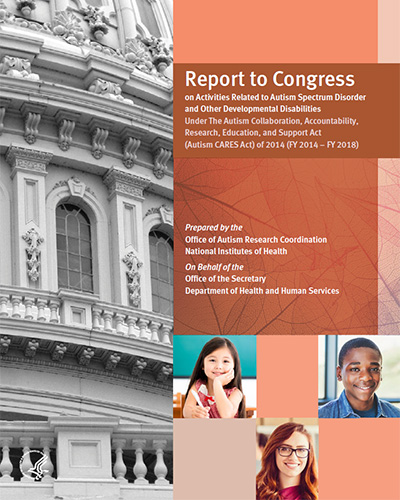Report to Congress
on Activities Related to Autism Spectrum Disorder and Other Developmental Disabilities
FY 2014 - FY 2018
Average Age of Diagnosis
This section addresses Subsection (D) of 399DD: "Information on the average age of diagnosis for children with autism spectrum disorder and other disabilities, including how that age may have changed over the 4-year period beginning on August 8, 2014, and, as appropriate, how this age varies across population subgroups." Information on the average age of diagnosis for individuals with ASD is provided by the CDC and HRSA.
Centers for Disease Control and Prevention
Most children who have autism are not diagnosed until after they reach age 4 years, even though many children can be identified before age 2 years. For the most recently published 2018 ADDM Network ASD prevalence study, which was based on children who were 8 years old in 2014 and the diagnostic criteria in the DSM-IV-TR, the median age of earliest known diagnosis was reported by subtype category. Age of first diagnosis ranged from 46 months for children diagnosed with autistic disorder (a more restrictive category suggesting higher severity of symptoms), to 56 months for children diagnosed under the more general category of pervasive developmental disorder (PDD) or ASD, and 67 months for children whose first diagnosis was Asperger disorder (a category describing children without significant delays in language development or intellectual ability).
In 2014, the ADDM Network reported the median age of earliest ASD diagnosis 4 years and 5 months for children aged 8 years living in ADDM Network communities. Data published in a previous report indicated that about 20 percent of these children had a different subtype diagnosed after their initial diagnosis, so there is some instability in these subtypes over time. It is unclear if this instability is due to challenges in the diagnostic presentation of the children. Relatively equal mixes of children were initially diagnosed with autistic disorder or PDD, but only 9 percent of children had an initial diagnosis of Asperger disorder.
CDC supports the Healthy People 2020 objective of increasing the proportion of children who are screened for autism and other developmental delays at 18 and 24 months of age and have a first evaluation by 36 months of age. For those with ASD, CDC supports increasing the proportion of children who are enrolled in special services by 48 months of age. An analysis of data from the 2007 National Survey of Children's Health (NSCH) indicates that only 21 percent of parents with children aged 10-47 months report that they were asked to fill out a questionnaire by a health care provider about their child's developmental, communication, or social behaviors in the last year. A more recent analysis of data from the 2016 NSCH indicated that an estimated 30 percent of parents with children aged 9-35 months report that they were asked to fill out a questionnaire by a healthcare provider about their child's developmental, communication, or social behaviors in the last year, and an estimated 37 percent of parents report that their children aged 9-35 months had received developmental surveillance from a healthcare professional in the past year. Data from the ADDM Network are used to monitor progress toward the Healthy People 2020 goal of increasing the proportion of children with ASD who have a first evaluation by 36 months of age to 47%. Insufficient progress has been made toward achieving this goal. The proportion of children aged 8 years with a first evaluation by age 3 was 43.3% as reported in 2014, 42.8% as reported in 2016 and 41.9% as reported in 2018 by the ADDM Network. It should be noted that the American Academy of Pediatrics recommendations for population screening of young children for ASD were published in 2007 and ADDM Network data for 8-year-old children may reflect improvement related to increased screening beginning in the 2014 and 2016 surveillance years (corresponding to births in 2006 and 2008).
Health Resources and Services Administration
The following are data from the 2016 National Survey of Children's Health (NSCH).
- For children 3-17 years, who had ever received an ASD diagnosis and currently had the condition, the average age of diagnosis was 4.9 years old.
- The average age by gender was 4.8 for males and 5.4 for females.
- The average age by race/ethnicity was 3.3 for Hispanics, 5.7 non-Hispanic whites, 4.7 for non-Hispanic blacks, and 5.8 for multi-race/other non-Hispanics.
- The average age by type of health insurance was 4.9 for public insurance only, 5.0 for private insurance only, and 5.3 for not insured.
- The average age by Federal Poverty Level (FPL) was 4.5 for < 100% of the FPL, 5.4 for 100-199% of the FPL, 4.7 for 200-399% of the FPL, and 5.3 for => 400% of the FPL.




